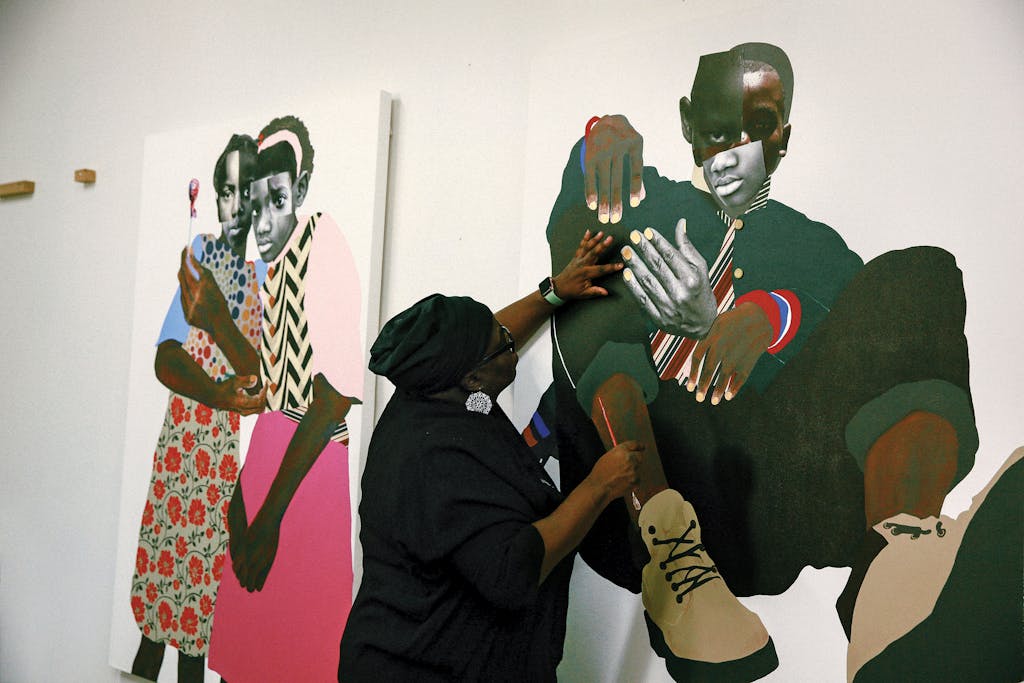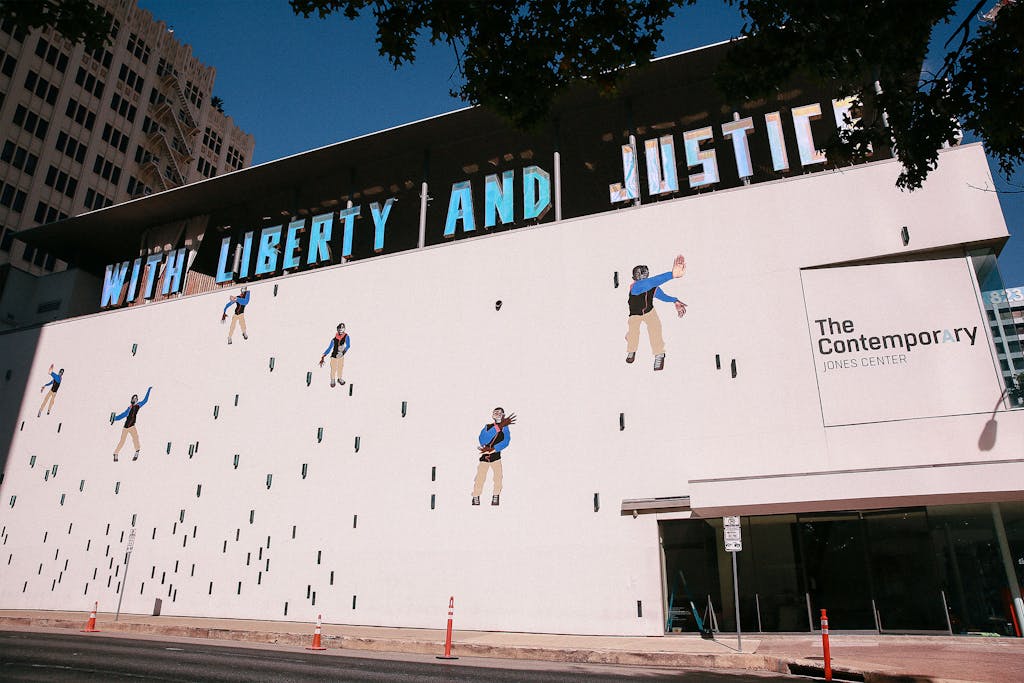When Deborah Roberts is about to start a new collage, she looks for a Black child’s face that possesses a certain purity. “It has to be a face that reminds me of someone who has not been touched by pop culture,” the Austin-based artist explains. “That’s the innocent person I want you to find in the multiplicity of faces.”
Once she’s found her “base face,” usually by searching online through images of young people from the Caribbean—most often Haiti—and various African countries, she’ll “collage the hell out of it,” manipulating the source image and then layering facial features borrowed from other photographs on top. Everything else, such as the child’s body, clothing, and accessories, is secondary.
When she started creating collages a decade ago, Roberts, who is now 58, focused on the experiences of Black girls who had reached the age when they begin absorbing conflicting ideas about beauty, self, and the adults they’ll eventually become. This time of self-actualization is particularly tricky for Black girls, who must grapple with negative messages about their Blackness: about hair that isn’t straight enough, skin that isn’t light enough, features that aren’t European enough.
In addition to bearing the weight of racist beauty standards, Black girls are burdened by “adultification,” a term used by researchers to describe how they are often seen as older and less innocent than their white counterparts. In nearly all of Roberts’s collages, at least one child is looking directly at the viewer, as if challenging us to remember that Black children are children.
Consider her 2018 mixed-media piece Red, white and blue, a 70-by-62-inch work on white canvas. Two Black girls in Converse shoes, each clutching a red boxing glove, stand back-to-back. Their clothes are a jumble of bright colors and patterns, a nod to the stylistic freedom of children. One of the girls, wearing a hijab, is rendered in profile; the other gazes directly at the viewer, an effect made even more jarring because Roberts has covered one of her eyes with an eye from a different person. While the subjects’ faces and hands are collaged, their bodies and most of their clothes are painted and drawn, which further calls our attention to their resolute expressions. Their shared stance declares that it’s them against the world. It’s clear that the figure on the right, who looks out of the canvas, is ready to fight—even if that means fighting the viewer. But there’s also that reminder in her eyes: She shouldn’t have to battle anyone or anything. She shouldn’t need a boxing glove.

Roberts, who was born in East Austin in the early sixties, has considered herself an artist since she was eight years old. Her mother, a housekeeper, and her father, an electrical lineman, were good parents, but they didn’t quite understand her determination to pursue art professionally. To them, art was a hobby, not a career. To Roberts, it’s always represented something bigger.
“Art has been at the center of my existence as a way of getting me through bad, unhappy times,” she says. “I can do art and go into a place for hours and exist there.”
One of those unhappy times was in the sixth grade, when, as part of the city’s half-hearted attempt to integrate, she was bused to Travis Heights Elementary School, just west of I-35. She was one of the only Black students in her school, and a white teacher, she says, was hostile toward her. “I had never been treated this way because [I had gone to] a school where teachers loved us and disciplined us and treated us equally,” she says. Roberts turned to art, drawing portraits of her celebrity crushes, El DeBarge and Michael Jackson.
Her dedication to her craft eventually led her to Denton, where she earned a bachelor’s degree in fine arts from the University of North Texas. After graduating, Roberts returned to Austin and established a free summer art workshop for teens called “Success Comes in Cans, Not Can’ts,” which lasted for eight years. In 1989, she opened the Not Just Art Gallery in West Lake Hills—a wealthy, largely white part of West Austin where she hoped to put her work and that of other artists in front of audiences who wouldn’t normally see it. At the time, Roberts was focused on figurative, detailed, Norman Rockwell–esque drawings of Black life, and she managed to sell a fair number of them. But running a gallery was an expensive proposition, and she struggled to get the numbers to add up; “drowning in debt,” she closed it after about ten years.
Over the ensuing decades, Roberts occasionally found herself living the stereotypical life of a starving artist, taking odd jobs such as baking at Safeway and selling shoes at Academy while she continued painting in her spare time. She never had a plan B. “I told somebody about four years ago that I was all in, that this was me to the end,” Roberts says, laughing. “Ride or die. Thank God things turned around.”
In the early 2010s, more than a quarter-century after she had last attended school, Roberts enrolled in the master of fine arts program at Syracuse University, in upstate New York. Among other goals, she hoped to ground her art more firmly in the literature of Black writers such as Cornel West, whom she had begun reading intensively. While at Syracuse, she decided to try a creative exercise that Franklin Sirmans, then a curator at the Menil Collection in Houston, had once suggested to her: make twenty works of art from one concept. The idea was to allow herself to work through everything she was thinking, to leave no notions unexplored, however half-baked or unrealized.

Art Car
Roberts had fans of her art as early as the third grade, when she traded pictures she’d drawn of racing cars with her classmates for an assortment of colored pencils.
One of her professors scoffed at the arbitrary nature of the practice. “Well, why twenty?” Roberts remembers her teacher asking. “Why not a hundred? Why not two hundred?”
“Oh, you think I can’t do two hundred?” she responded.
Rising to the challenge, Roberts bought four thick twelve-by-twelve-inch sketchbooks and began “exercising my brain,” as she puts it. In the end, Roberts overshot her goal, creating 225 works. Some of her first collages emerged from this period, including many of the pieces in her Little Debbie series, which were made out of pictures of Roberts as a child. The exercise resulted in some hits. And some misses.
“I could look at some of them today and say, ‘Oh, my God. Ew,’” Roberts says. “I know they were bad, but it’s just like any type of muscle or exercise. You have to do it multiple times until you start to get that rhythm.”
The three years she spent in Syracuse allowed her to achieve the sort of breakthrough for which she had been reaching. She transitioned away from her Rockwell-style drawings and focused on her collages of Black girls. And, not quite overnight, the shift paid off.
In 2017, Roberts presented her new collages at the Volta Art Fair, in New York, an international event focusing on both emerging and established artists. There, her work captivated buyers and critics from around the world. Word started getting around. The following year, she held her first solo museum exhibition, “Deborah Roberts: The Evolution of Mimi,” at the Spelman College Museum of Fine Art, in Atlanta. In 2018, she was invited to the monthlong Fountainhead residency, in Miami, and in 2019, she participated in the Robert Rauschenberg Foundation residency.
For years, Roberts had created art in her small one-bedroom apartment. But by 2018 she was making enough money that she was finally able to afford her own studio space, at Canopy Austin, a collection of studios and galleries. And this past March, she moved into a brand new house.

Since Roberts’s success at the Volta Art Fair, her work has been exhibited at the Studio Museum of Harlem, the National Portrait Gallery in Washington, D.C., and London’s prestigious Stephen Friedman Gallery, among others. Beyoncé, Ava DuVernay, and Padma Lakshmi are just some of her celebrity fans. But she’d never had a solo museum show in Texas—an omission that has finally been rectified. On January 23 “Deborah Roberts: I’m” opens at the Contemporary Austin; it will run through August 15.
The exhibition features about two dozen works, including the collages for which she’s best known, as well as text-based pieces screen-printed on 30-by-22-inch paper. One such piece is We ≥ They, in which those titular words stand alone against a white background, leaving it up to viewers to work out whether the “We” and “They” refer to gender, race, nationality, or some other fiercely contested form of identity. Another component of the exhibition, an interactive booth that Roberts describes as “a space that feels like being in the Black body,” is similarly dependent on the perspective of the viewer. The installation is a reappropriation of a Catholic confessional, in which viewers find a mirror rather than a priest. The piece forces participants to confront their own reactions to audio and video generated by Roberts—some of which includes racist content. “I never know what you get to think about it,” Roberts says. “It’s between you and yourself.”
A standout element of the exhibition is Little man, little man, a mural on the southern wall of the Contemporary’s exterior, facing pedestrians and eastbound traffic on 7th Street. The facade features six collages of a young Black boy, which represent an expansion from her focus on Black girls that occurred a few years ago, after a number of Black men told her that they felt her art was lacking their perspectives. One of the most powerful works she has made since then is a series of collages, titled Nessun dorma, about George Stinney Jr., a fourteen-year-old Black boy from South Carolina who was executed in 1944 after he was convicted of murdering two white girls. (His conviction was overturned in 2014.)
But the piece on the Contemporary’s exterior is of a completely different register. This unnamed boy’s flailing limbs appear as though he’s performing popular Black dance moves, such as the Woah and the Nae Nae. He looks exuberant and free, an embodiment of the social media phrase #BlackBoyJoy, which seeks to reclaim the rapture of childhood for Black men and boys, who are often denied the innocence of youth. It’s a poignant piece, especially if you glance upward to take in the iridescent textual sculpture by New York–based artist Jim Hodges, installed along the south and east edges of the museum’s roof in 2016. It reads, “With liberty and justice for all.”
Of course, Roberts’s collages of Black girls remain a core of the exhibition—but even those reflect changes in her work. One major stylistic deviation is the use of black backgrounds in some of the collages. Roberts has typically set her pieces against white or faintly hued backdrops, bringing to mind the words of the writer and anthropologist Zora Neale Hurston: “I feel most colored when I am thrown against a sharp white background.” But in Portraits: When they look back (No. 3), two Black girls’ lightly outlined and shaded arms and dresses blend in with a black canvas, suggesting a more welcoming space for them.
This fall, “I’m” will travel to the Museum of Contemporary Art Denver, and Roberts is already preparing for another solo exhibition at Vielmetter Los Angeles in September. But she regards her Austin exhibit as an important milestone. After five decades, it’s a chance to finally show her hometown what she can do.
“I’ve been here, and you just didn’t see me,” Roberts says. “But I’ve been here.”
This article originally appeared in the February 2021 issue of Texas Monthly with the headline “Hometown Glory.” Subscribe today.









